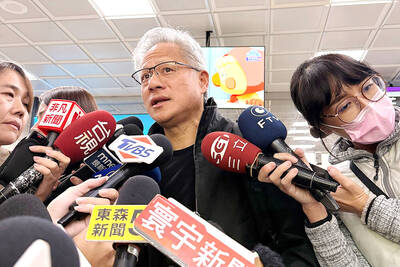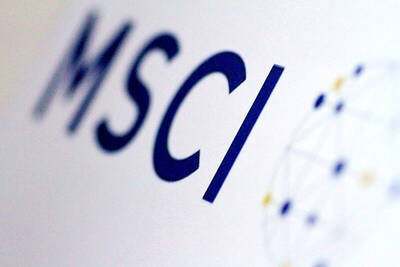Stock prices of the nation's major computer memory chipmakers outperformed the main bourse yesterday amid speculation on further price rebounds.
This came after disruption at a Chinese plant belonging to the world’s second-largest memory chipmaker Hynix Semiconductor Inc, which could lead to an ease in a supply glut.
Shares of the nation’s biggest dynamic random access memory (DRAM) chipmaker, Powerchip Semiconductor Corp (力晶半導體), jumped 0.78 percent to NT$13 yesterday, better than the turbulent TAIEX index, which fell 2.43 percent.
South Korean Hynix yesterday said the 15-hour outage at a Chinese plant operated jointly with Numonyx, a joint venture with STmicroelectronics, Intel and Francisco Partners, would not have a major adverse effect as emergency power generation activated immediately.
The affected plant, located in Wuxi, southern China, makes 100,000 12-inch wafers of DRAM chips a month, accounting for about half of the Korean firm’s total DRAM chip output. Hynix also operates an 8-inch plant in Wuxi, making memory chips used in consumer electronics.
“Hynix’s power outage may affect one week’s worth of production,” Taipei-based market researcher DRAMeXchange Technology Inc (集邦科技) said in a statement yesterday.
DRAMeXchange said the output disruption greatly boosted the spot price of benchmark DDR2 1Gb 128Mx8, which jumped 1.21 percent to US$2 per unit yesterday following an almost five percent decline during the slow season last week.
Hynix said the outage on Monday was likely to result in a US$16million to US$18 million loss in sales. It would take about two days for the plant to resume normal operations, the chipmaker said.
Lehman Brothers Holdings Inc estimated that supply could be cut by 3 percent to 4 percent in the next one to two months.
Stock prices of the nation’s third-largest DRAM chip supplier ProMOS Technologies Inc (茂德科技) climbed 0.37 percent, while Nanya Technology Corp (南亞科技) was down 0.77 percent.
Separately, DRAMeXchange expected the contract price of DRAM chips to recover by an additional five percent to 10 percent in the second half of this month, helped by slower output expansion and early demand for back-to-school shopping season.
ADDITIONAL REPORT BY BLOOMBERG

PERSISTENT RUMORS: Nvidia’s CEO said the firm is not in talks to sell AI chips to China, but he would welcome a change in US policy barring the activity Nvidia Corp CEO Jensen Huang (黃仁勳) said his company is not in discussions to sell its Blackwell artificial intelligence (AI) chips to Chinese firms, waving off speculation it is trying to engineer a return to the world’s largest semiconductor market. Huang, who arrived in Taiwan yesterday ahead of meetings with longtime partner Taiwan Semiconductor Manufacturing Co (TSMC, 台積電), took the opportunity to clarify recent comments about the US-China AI race. The Nvidia head caused a stir in an interview this week with the Financial Times, in which he was quoted as saying “China will win” the AI race. Huang yesterday said

Nissan Motor Co has agreed to sell its global headquarters in Yokohama for ¥97 billion (US$630 million) to a group sponsored by Taiwanese autoparts maker Minth Group (敏實集團), as the struggling automaker seeks to shore up its financial position. The acquisition is led by a special purchase company managed by KJR Management Ltd, a Japanese real-estate unit of private equity giant KKR & Co, people familiar with the matter said. KJR said it would act as asset manager together with Mizuho Real Estate Management Co. Nissan is undergoing a broad cost-cutting campaign by eliminating jobs and shuttering plants as it grapples

The Chinese government has issued guidance requiring new data center projects that have received any state funds to only use domestically made artificial intelligence (AI) chips, two sources familiar with the matter told Reuters. In recent weeks, Chinese regulatory authorities have ordered such data centers that are less than 30 percent complete to remove all installed foreign chips, or cancel plans to purchase them, while projects in a more advanced stage would be decided on a case-by-case basis, the sources said. The move could represent one of China’s most aggressive steps yet to eliminate foreign technology from its critical infrastructure amid a

MORE WEIGHT: The national weighting was raised in one index while holding steady in two others, while several companies rose or fell in prominence MSCI Inc, a global index provider, has raised Taiwan’s weighting in one of its major indices and left the country’s weighting unchanged in two other indices after a regular index review. In a statement released on Thursday, MSCI said it has upgraded Taiwan’s weighting in the MSCI All-Country World Index by 0.02 percentage points to 2.25 percent, while maintaining the weighting in the MSCI Emerging Markets Index, the most closely watched by foreign institutional investors, at 20.46 percent. Additionally, the index provider has left Taiwan’s weighting in the MSCI All-Country Asia ex-Japan Index unchanged at 23.15 percent. The latest index adjustments are to